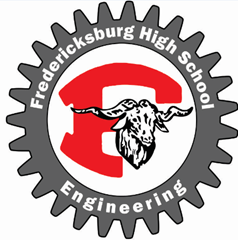The Goddard level rockets, which are the capstones of the SystemsGo program and the culmination of all the skills the students have learned throughout their years in the STEM program are set to launch June 21-23. This marks the final senior project for the schools that participate in this level of the SystemsGo program.
Redbird #20 is scheduled for testing at White Sands Missile Range (WSMR) Sunday, June 23. This marks the last big event for Rockets 2019 and the Fredericksburg Engineering/Rocket Program.
As of today, May 31, when I was able to get a report on the rocket’s status, from team member, Dawsen Harkins, was in good standing. He reported that as of May 30, the nosecone had been assembled and covered with its first layer of fiberglass.
 In this photo the nose cone ring is being secured in place, and centered by skewers for fiberglassing.
In this photo the nose cone ring is being secured in place, and centered by skewers for fiberglassing.
Although, the tank required 2 trips to SRM to have leaks rewelded, it has now completed its pressure testing successfully.  It will be returning to SRM again to have the hatches and holes cut in.
It will be returning to SRM again to have the hatches and holes cut in.
New for this year is a piston valve system. This has also performed well when tested.
This year’s rocket is supporting three payloads. The first came from Harvard University, courtesy of former FHS student, Joseph Sanchez, who attends school there. It is a CubeSat with a pneumatically deployed solar panel.
They second one was created by Keith Jenkins, the FHS IT guy. It is a small electronics bay.
The third the team provided. It is a GoPro camera. It will be positioned behind an acrylic window in the hatch, so that it can look out and video the vehicle’s flight.
According to Harkins, “All components bays have been made and 3D printed and fit perfectly in the rocket.”
The fuel grain is also on the task list. They have assembled the mold for pouring it. One part of the mixture for the fuel grain is still not in but they will be mixing and pouring it as soon as this arrives.
As of this report, supplied last Friday, the following list of things is left and then they are FRR complete.
- Complete the fiberglassing of the nose cone.
- Make the fuel grain and assemble the motor system.
- Assemble the recovery system.
- Weld fins to body.
- Cut hatches and have holes drilled in the body tube.
- Fix minor little things for flight.
The current list of students from this team attending the WSMR launch is as follows:
Rodolfo Avila, Cody Blohm, Gloria Burns, Alexander Casteneda, Lucio Castro Vazquez, Clayton Ellebracht, Jose Escalante, Jabin Gipson, Dawsen Harkins, Cooper McDonald, Eduardo Memije, Bradley Plaza, Joshua Reese-Hadley, Nicholas Rodriguez, Robert Sanchez, Deja Turkett, Gabriel Voorhees, Carl Wilger, and Robert Zowie.
Currently there is not a team picture available, but here is Nick Rodriguez, Deja Turkett and Dawsen Harkins taking a work break on the stairs at FHS. 
Launches are scheduled for June 21st and June 23rd. The team will travel out to WSMR on Wednesday, June 20th, and back home again on the 24th.
There are 7 schools scheduled to launch 8 rockets. These schools include:
- Alamo Heights
- Anahuac
- Booker T. Washington
- Brazoswood
- Fredericksburg
- Marble Falls
- Union Grove
The current launch schedule is as follows:
- Thursday, June 2oth
- Travel Day
- Friday, June 21st
- Mrorning-T-1/Site Set up WC-50; Afternoon-Launch Union Grove & Alamo Heights ( or whichever rockets are ready)
- Saturday, June 22rd
- Launch Day Two (Four Rockets-Booker T., Anahuac, Marble Falls, & Brazoswood)
- Sunday, June 23rd
- Launch Day Two (Two Rockets-Fredericksburg & Booker T Washington)
- Monday, June 24th
- Travel Day (Could travel home on the 23rd if operations are complete in time.)
This article is for the 2018/2019 school year to update the Fredericksburg Engineering/Rocket program. This school is a participant of the SystemsGo STEM program. This series of articles is intended to support and encourage students in the program as they share their working status and accomplishments throughout the year in the program. These publications will be available for tags and re-posting.
www.systemsgo.org as always is the place for more information on this program. You may also email them at info@systemsgo.org .Take the time to get your school involved, the future of your students will be greatly benefited.
#Rockets2018 #SystemsGo #FredricksburgSTEMAcademy #Launcher01 #RideTheSky #Texasrockettrail



 This was for fun, and is freshman doing something wacky!
This was for fun, and is freshman doing something wacky! Cade Terry, Travis Klokker, Sam O’Leary
Cade Terry, Travis Klokker, Sam O’Leary  Hayle Mayer, Tyler Smedley, Daisuke Kyan
Hayle Mayer, Tyler Smedley, Daisuke Kyan  Karson Hagel, Gerry Balderas, Roan Hager
Karson Hagel, Gerry Balderas, Roan Hager  Michael Flores, Carlotta Wilkinson, Kris Ersch, Davis Englert
Michael Flores, Carlotta Wilkinson, Kris Ersch, Davis Englert

 Corbin Smajstrla, Sergio Walle, Bryce Erwin, Pierce Vasquez, Evan Knapp, and Harrison Spisak prepare to test the RB17/19 tank.
Corbin Smajstrla, Sergio Walle, Bryce Erwin, Pierce Vasquez, Evan Knapp, and Harrison Spisak prepare to test the RB17/19 tank. Luke Duderstadt working on Autocad.
Luke Duderstadt working on Autocad. Bradley Plaza and Carl Wilger prepare to launch their Generation 3 rocket.
Bradley Plaza and Carl Wilger prepare to launch their Generation 3 rocket. Jabin Gipson and Rudy Avila model their Generation 3 rocket on launch day.
Jabin Gipson and Rudy Avila model their Generation 3 rocket on launch day. Pictured here is the seniors’ flow straightener prototype for their wind tunnel. It was 3D printed on a Makerbot.
Pictured here is the seniors’ flow straightener prototype for their wind tunnel. It was 3D printed on a Makerbot.